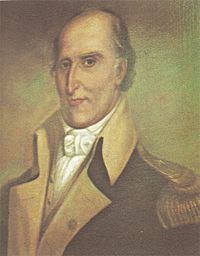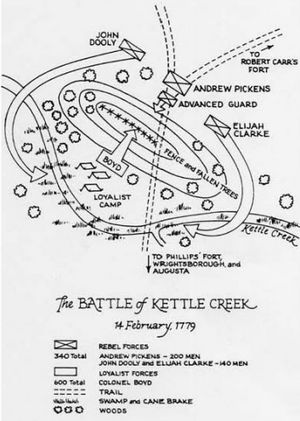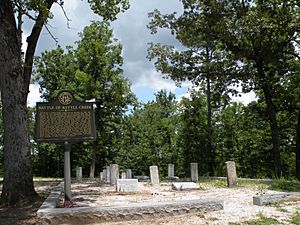Battle of Kettle Creek facts for kids
Quick facts for kids Battle of Kettle Creek |
|||||||
|---|---|---|---|---|---|---|---|
| Part of the American Revolutionary War | |||||||
 Andrew Pickens, portrait by Thomas Sully |
|||||||
|
|||||||
| Belligerents | |||||||
| Commanders and leaders | |||||||
| John Boyd † William Spurgen |
Andrew Pickens John Dooly Elijah Clarke Col. James Little |
||||||
| Strength | |||||||
| 600–700 militia | 340–420 militia | ||||||
| Casualties and losses | |||||||
| 40–70 killed 75 wounded or captured |
7–9 killed 14–23 wounded or missing |
||||||
The Battle of Kettle Creek was an important fight during the American Revolutionary War. It happened on February 14, 1779, in Wilkes County, Georgia, near what is now Washington, Georgia. This battle was the first big win for the Patriots (Americans fighting for independence) in the back country of Georgia.
In this battle, a group of Patriot fighters, called a militia, strongly defeated a group of Loyalists. Loyalists were Americans who wanted to stay loyal to the British King. The Loyalist group was on its way to Augusta, which was controlled by the British.
This victory showed that the British could not easily control the inner parts of Georgia. It also showed they couldn't protect Loyalists who were far from British-held areas. Even though the British later won a small battle at Brier Creek, Georgia's back country stayed mostly free from British control until 1780.
Contents
Why the Battle Happened
The British had a plan to win the war by focusing on the Southern states. This plan was called the Southern Strategy. They sent soldiers from New York City and Saint Augustine to capture the important port city of Savannah, Georgia.
British Take Control of Augusta
In December 1778, British soldiers captured Savannah. Then, in January 1779, British General Augustine Prevost arrived. He sent a group of soldiers, led by Lieutenant Colonel Archibald Campbell, to take control of Augusta. Augusta was another key city in Georgia.
Campbell and over 1,000 men reached Augusta with little trouble. The American General Andrew Williamson had been defending Augusta with about 1,000 Patriot militia. But he pulled most of his men back when Campbell got close.
Campbell started asking Loyalists to join the British side. By February 10, 1779, about 1,100 men signed up. However, only a few actually joined the British army. Campbell also made people swear loyalty to the British King. Many people took the oath but secretly still supported the Patriots.
Campbell sent Major John Hamilton to find Loyalists in Wilkes County. He also sent Lieutenant Colonel John Boyd to gather Loyalists in North and South Carolina. Boyd was very successful and recruited several hundred men. As he traveled back towards Augusta, more Loyalists joined him. His group grew to over 600 men. As Boyd's group moved, they took supplies and caused trouble. This made many Patriots angry and ready to fight.
The Battle Begins
Boyd's Loyalist camp was not very careful, even though they had guards. The Patriots, led by Andrew Pickens, moved forward. Pickens led the middle group. Colonel John Dooly led the right side, and Lieutenant Colonel Elijah Clarke led the left side.
When Patriot scouts fired at the Loyalist guards, Boyd realized what was happening. Boyd quickly formed a defense line. He moved forward with 100 men to face Pickens. They used a simple wall made of fences and fallen trees for protection. Pickens had the advantage of being on higher ground. He was able to go around Boyd's defense, even though his own sides were slowed by swampy land near the creek.
There was heavy fighting, and Boyd was badly wounded. His small group had to retreat to the main Loyalist line. Then, the Patriot groups on the sides came out of the swamps. The Loyalists, now led by Major William Spurgen, fought the Patriots for 90 minutes. Some Loyalists tried to cross the creek, leaving their horses and gear behind. Clarke noticed some higher ground across Kettle Creek where the Loyalists seemed to be heading. He led some of his men there, and his horse was shot during this move. Eventually, the Loyalist line broke, and their men were killed, captured, or ran away.
What Happened Next
Pickens captured 75 Loyalists. Between 40 and 70 Loyalists were killed. The Patriots had 7 to 9 killed and 14–23 wounded or missing. Many of Boyd's men went home after the battle. Some were captured later, and some surrendered to Patriot leaders. About 270 of Boyd's recruits eventually joined the British army.
Pickens found the badly wounded Boyd after the battle. Boyd, who knew Pickens from before the war, asked Pickens to give a special pin to his wife and tell her what happened. Pickens did this later.
Of the Loyalist prisoners, only about 20 survived their injuries. Pickens took them to Augusta, then to Ninety Six. There, they were held with many other Loyalists. Leaders in South Carolina wanted to make an example of them. They put some Loyalists on trial for being disloyal to their new country. About 50 were found guilty, and five men, including some captured at Kettle Creek, faced severe punishment.
British military leaders were very angry about how these prisoners were treated. General Prevost threatened to treat Patriot prisoners badly in return. But he did not, because he worried that other British prisoners held by Americans might also be harmed. Later, South Carolina officials dropped most of the charges.
British Response
On February 12, Campbell decided to leave Augusta. He began moving his troops back to Savannah on February 14, the same morning the battle happened. Campbell did not leave because of the battle's outcome. He didn't know about the battle until after he had already left Augusta. He left because more Patriot soldiers were arriving, he was running low on supplies, and he wasn't sure if Boyd's mission would succeed.
The Patriot victory at Kettle Creek was partly overshadowed by a British win a few weeks later. This was the Battle of Brier Creek on March 3, which happened during Campbell's retreat. Augusta was later taken back by the British in June 1780. But Patriot forces took it back again on June 5, 1781.
Battlefield Today
The Kettle Creek Battlefield is now a special historical site. Most of the battlefield is owned by Wilkes County. In 2008, experts found the exact spot where the main fight happened. It is located off Tyrone Road in Wilkes County.
In 2013, the Kettle Creek Battlefield Association bought 60 acres of the battlefield. They used money from donations and other groups. Then, in 2018, the American Battlefield Trust and its partners bought and saved another 180 acres of the battlefield. In January 2021, the Kettle Creek Battlefield was given a special status by the National Park Service.
Images for kids







